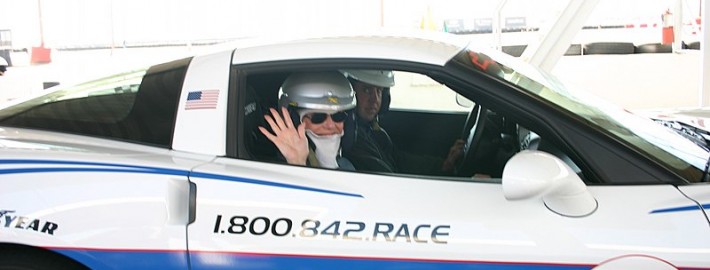A Fast-Track Approach to Risk Management Skills
When they handed me the helmet and fire protection gear, I knew this would not be an ordinary car ride.
I’m strapped into the passenger seat of a powerful 6-speed race-ready Corvette C5 coupe at the Bondurant School of High Performance Driving in Phoenix, Arizona, waiting for driving instructor/pro race driver Mike Speck to slam the rumbling machine into gear.
“You OK with speed?” he asks nonchalantly.
“Love it!” I confess.
Like touching a torch to a rocket, Mike floors it, roaring out of the pit area, taking me on a slam-against-the-seat careening chase through the tortuous 15-turn 1.6 mile road course where the likes of Paul Newman and Tom Cruise trained for roles in racing movies, and the best-of-the-best NASCAR and open wheel racers fine-tune their already considerable skills.
I can’t see the speedometer but I know we are flying and I secretly wish that I was behind the wheel. But that would only happen if I’d officially enrolled in one of the courses at “the Official High Performance Driving School of General Motors.”
And what, you ask, does my over-the-top experience have to do with business travel? Actually, more than you might think.
The sprawling 60-acre Bondurant facility located on the Gila River Indian Community in the flat desert reaches of the south Phoenix metroplex teaches students a lot more than how to win at Daytona or the Indy 500.
The Bondurant School and a few others like it around the country offers a number of executive protection programs that include defensive driving and skillful vehicle handling. It’s here that business executives or the staff that drive them learn how, in a nutshell, to stay safe on the road and, when necessary, to get away from the bad guys.
Executing maneuvers like “take-outs” (student “good guy” car comes up behind the “bad guy” car and makes light contact, puts weight on the rear bumper to get the car to spin out. The “good guy” car positions his front fender to rear fender, unloads the weight and makes the “bad guy” car spin), drivers learn how to survive the unexpected in countries (including the U.S.) where roads and the people that drive them can be dangerous.
Not surprisingly, the demand for this kind of knowledge is escalating, as businesses globalize and travelers routinely make and nurture contacts in locations where heightened awareness and preparation could be life-saving. Companies that scrutinize travel costs are increasingly aware that protecting the people who travel for them is just one more component of that significant investment.
According to a recent survey of U.S. and U.K. travelers, 80 percent think their company has a legal obligation to ensure their safety while they’re traveling abroad, but more than 46 percent work for firms with no clear travel security policy.
Risk management for business travelers cuts a wide swath. Terrorism, kidnapping and robberies are the more dramatic possibilities, but severe weather, pandemics, earthquakes, and other unforeseen events like worker strikes or suddenly-altered foreign entry requirements can wreak havoc on a routine trip.
Crummy highways enter into the mix too. As any veteran global business traveler knows, driving some countries’ underdeveloped roads can quickly escalate into a potentially life-threatening scenario.
David Marks, general manager of online services for International SOS , a provider of medical and security information and protections, believes that there is both a moral obligation and economic incentive to manage corporate travel risk. Aside from the obvious moral duty, Marks suggests that employees who know their company is looking out for them are likely to be more productive and motivated.
And then there is the legal responsibility of companies to keep employees informed of potential hazards and to protect their health and safety when they are traveling. Some refer to it as “managing risk, not risk aversion.”
The U.K enacted the Corporate Manslaughter and Corporate Homicide Act, legislation that holds employers in those countries liable if their “gross failure” to provide protection results in an employee death. The legislation grew out of an incident where a British traveler returned to Great Britain in a severely-fatigued state after several long flights and was killed in a car accident on his drive home from the airport.
While it might seem that these warnings are intended for commercial enterprises doing business in remote locations or developing countries, the heads-up can apply to any organization that sends travelers out to do its business.
For example, universities that send travelers on countless trips to conferences, on speaking engagements and on extended-stay research projects to every imaginable location across all continents is a case in point.
Companies like iJet Intelligent Risk Systems offer early-alert programs for corporate travel managers who need to track their travelers’ whereabouts and, if necessary, alert them to escalating threats when they are on the road. Their WorldCue Travel Risk Management program monitors travelers’ destinations 24/7 and issues threat alerts when required.
To help companies determine what kind of services and tools they need, iJet in cooperation with the Global Business Travel Association built the Travel Risk Management Maturity Model, a benchmarking tool that helps corporations and organizations evaluate the maturity of their risk management programs, from level one, or “reactive,” to level five, “optimized.” Companies that find themselves at the “reactive” level are considered at substantial risk and subject to significant liability for not meeting travelers’ basic duty of care.
A recent article in “Travel Procurement Magazine” points out that travel related decisions must begin well before a trip is booked. Whether you train travelers yourself to avoid risk, hire international security experts to do it for you, or sign on with a company like iJet or International SOS, the key words to remember are these:
“Measure, monitor, mitigate.” And I’ll add a few more:
Make a trip to Phoenix for a defensive driving class. It’s a blast!”


